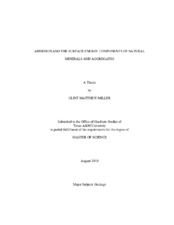| dc.description.abstract | A range of geochemical reactions are controlled by the interfacial characteristics
of rocks and minerals. Many engineered and natural systems are affected by
geochemical reactions that occur at interfaces. Asphalt-aggregate adhesion in road
construction is influenced by the interfacial characteristics of the aggregate. Likewise,
the remediation of nonaqueous-phase liquid contaminants, such as trichloroethylene or
methyl tert-butyl ether, is controlled by the interactions between mineral surfaces and
the organic liquid. Many natural systems are also influenced by reactions at interfaces.
The migration of petroleum in sedimentary basins is influenced by the wettability of the
surfaces of the basin pore space. Adhesion of organisms, such as bacteria or lichens, to
rock surfaces is controlled by the interactions of proteins and mineral surfaces.
Rock and mineral surfaces are described by surface energy. Surface energy is a
thermodynamic construct defined as the amount of work required to form more of a
surface. Surface energy can be divided into van der Waals, Lewis acid, and Lewis base
components. The ability to predict the magnitude of surface energy components is
valuable in understanding species behavior. Surface energy is controlled by three master
variables: surface chemistry, surface morphology, and surface coatings. While the
surface energy of a number of minerals and aggregates has been characterized, there has
not yet been a comprehensive study of the surface energies of a variety of the most
common minerals and aggregates using consistent methodology. In addition there has not yet been a study of the effect of these three master variables on surface energies of
natural minerals and rocks.
This study measured the surface energy of 22 common minerals and 7
aggregates. The samples’ bulk and surface chemistries were characterized with
wavelength and energy dispersive spectra analyses on an electron microprobe and x-ray
photoelectron spectroscopy. The XPS was also used to quantify the organic and
inorganic coatings on the surfaces. Results showed that van der Waals surface energy is
typically between 40 and 60 ergs/cm2. Polar surface energy varies by 1 to 3 orders of
magnitude, and thus is likely the most important component in accounting for changes
between natural minerals. | en |


